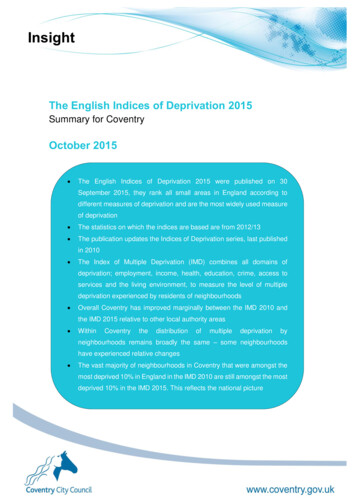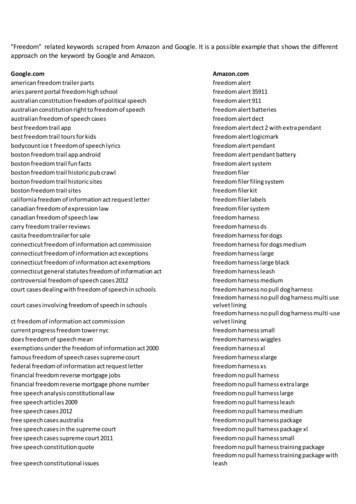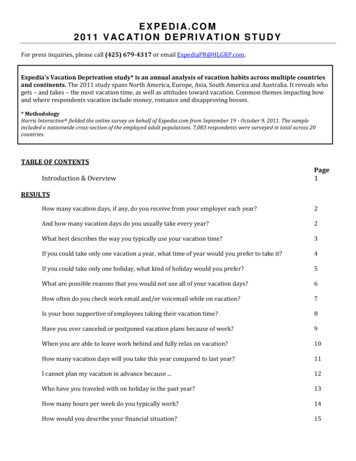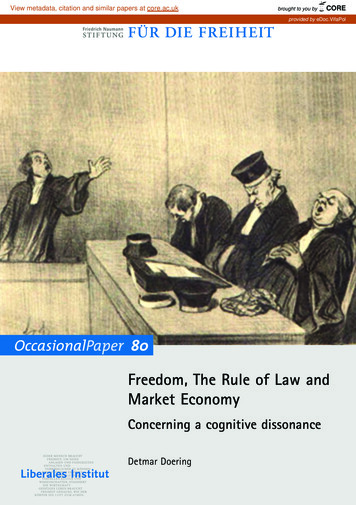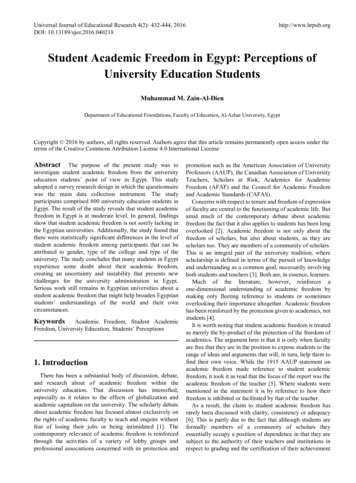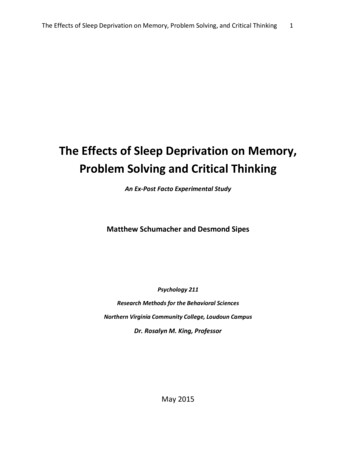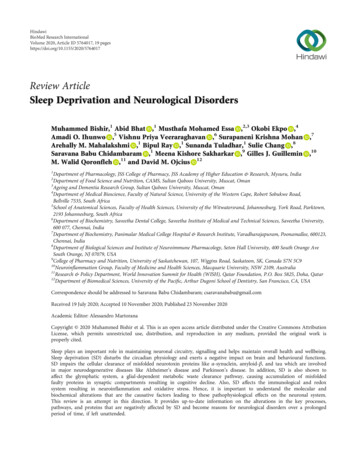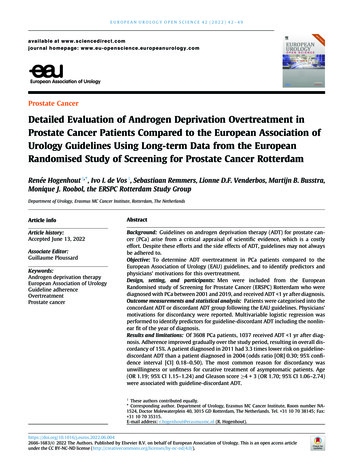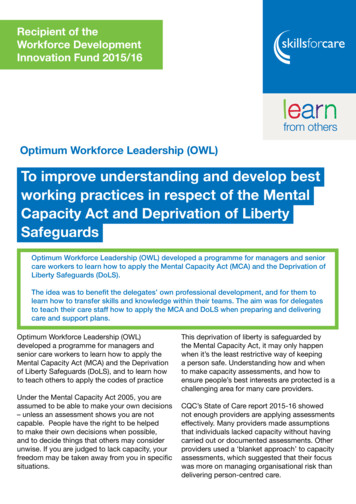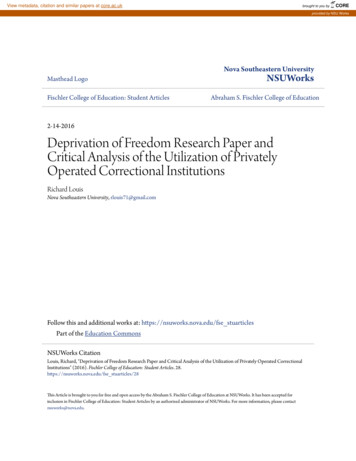
Transcription
View metadata, citation and similar papers at core.ac.ukbrought to you byCOREprovided by NSU WorksNova Southeastern UniversityNSUWorksMasthead LogoFischler College of Education: Student ArticlesAbraham S. Fischler College of Education2-14-2016Deprivation of Freedom Research Paper andCritical Analysis of the Utilization of PrivatelyOperated Correctional InstitutionsRichard LouisNova Southeastern University, rlouis71@gmail.comFollow this and additional works at: https://nsuworks.nova.edu/fse stuarticlesPart of the Education CommonsNSUWorks CitationLouis, Richard, "Deprivation of Freedom Research Paper and Critical Analysis of the Utilization of Privately Operated CorrectionalInstitutions" (2016). Fischler College of Education: Student Articles. 28.https://nsuworks.nova.edu/fse stuarticles/28This Article is brought to you for free and open access by the Abraham S. Fischler College of Education at NSUWorks. It has been accepted forinclusion in Fischler College of Education: Student Articles by an authorized administrator of NSUWorks. For more information, please contactnsuworks@nova.edu.
Assignment 1 Topic 3 Deprivation of FreedomResearch Paper and Critical Analysis of the Utilization of Privately OperatedCorrectional InstitutionsbyRichard LouisEDD 8442 CRN 30280Ethics and Social ResponsibilityNova Southeastern UniversityFebruary 14, 2016
2IntroductionAccording to Merriam-Webster’s dictionary, one of the definitions of deprivation is thestate of being deprived of something. In addition, Merriam-Webster has one of its definitions offreedom as the liberation from slavery or restraint or from the power of another.According to Meiners (2011), the United States of America has the unfortunatedistinction of having the most incarcerated individuals than any other nation. The United Statesof America has 5% of the world’s population, however incarcerates 25% of the world’s totalprison population (Meiners, 2011).The incarceration numbers have only increased since the 1970’s not due to increases incrime, but due to legislation such as New York State’s Rockefeller Drug Laws, three strikes andyou are out, mandatory minimum sentencing and the war on drugs (Meiners, 2011).According to Anderson (2009), the nationwide inmate population increasing from200,000 in 1971 to over two million in 2008 has presented fiscal challenges to federal, state, andlocal government in the United States. The growth in the inmate population has resulted inserious fiscal challenges for municipalities. The primary resolution to this challenge has been forgovernments to depend on private, non-governmental entities to build and operate correctionalfacilities to house inmates convicted and sentenced by the respective municipality (Anderson,2009). When studying the population of inmates who take college courses, Anders and Noblit(2011), found that 62% of the student inmate population was african-american. Since the inmatestudent population, closely relates the overall prison population nationwide, the question can beasked if the advent of the private run correctional facilities is having a disproportionate effect onminorities being warehoused into the prison system. The writer will examine the utilization of
3privately operated correctional institutions to determine if their existence and purpose ultimatelyleads to a deprivation of freedom.History and Growth of the Private Prison IndustryAccording to Marion (2010), in 2006 the number of individuals incarcerated in theUnited States topped 7.2 million individuals. This trend resulted in states as well as the federalgovernment, spending billions of dollars annually to house and supervise inmates (Marion,2010). In the 1980’s the most efficient remedy that states decided to utilize to reduce theseexpenses was to enter into contracts with construction and management firms specializing inprivate corrections (Marion, 2010). These firms such as Corrections Corporation of America arepublicly traded and only have the objective of making profits (for their stockholders) through theimprisonment of individuals (Marion, 2010). When a municipality seeks to have a new prisonbuild, a bidding process is commenced in order to see which corporation will obtain the bid(Marion, 2010). Once the bid is approved, the prison is build and the inmates are provided by themunicipality’s department of corrections and then the private corporation receives a per diem foreach inmate housed in the private facility (Marion, 2010).The for-profit private prison operation originated as far back as the post-reconstructionera (Marion, 2010). In this era, the southern economy was devastated by the abolishment ofslavery, however many businesses were still in need of a large pool of cheap labor (Marion,2010). Many laws were passed allowing prisons to lease their prisoners to plantation owners andprivate firms that bore the cost of inmate upkeep, this is what was called convict leasing(Marion, 2010). In addition, many former slaves were homeless and could not find work andmany of these new laws including laws of vagrancy which did not specify offenders by colorhowever disproportionally these offenders were african-american which put many of these
4individuals square in the center of the convict leasing program which exposed them to conditionsvery similar to slavery (Marion, 2010). The practice of convict leasing would have offendersworking for meager wages under abusive conditions, while contributing to the sustainability ofthe bottom line of plantation owners and private firms in which they had to serve. As weapproached the 1920’s the practice of convict leasing and private prisons were largely eradicatednot due to social conscious but due to the advocacy of labor reform advocates that protested thatcheap prison labor constituted unfair competition (Anderson, 2009).As we approach the present day, according to Anderson (2009), the privatization ofprisons began to become present in various admininstrative functions. The private industrypresence began with the contracting of food and medical services and eventually various otheroperations functions until when the entire institution was privately managed (Anderson, 2009).The incarceration rate began to boom even more due to in part, the war on drugs and mandatoryminimum sentences (Brewer & Heitzeg, 2008). The need for privatization became apparent inthe eyes of municipalities when as recently as 2004, the United States had the highestincarceration rate in the world as for every 100,000 U.S. citizens, 699 of them were in prison(Brewer & Heitzeg, 2008). Due to the alarming rate of incarceration, municipalities werewitnessing their corrections budgets becoming unmanageable, in addition the political rhetoric oftough on crime and buliding more prisons would garner the support of the electorate to supportprivately run prisons (Anderson, 2009). However, the ultimate motivation for the movement toprivate prisons is predominantly financial (Sigler, 2011). As with various other municipalities,California would contract a private firm such as the GEO Group in which the cost per inmate tothe state would be 60 a day compared to the state undertaking the cost per inmate which wouldbe 118 per day (Sigler, 2011). Due to the financial attractiveness of privatization of correctional
5institutions, currently the federal government contracts all of its correctional services (38,000inmates held within privatized institutions) to private firms as well as thirty of the fifty UnitedStates of America (Ramirez, 2015).Private Prison DebateAccording to Ramirez (2015), private correctional institutions are for profit detentionfacilities owned and operated by private firms while contracted by a government agent. Theproponents of private correctional institutions make the argument that this partnership results inmonetary savings to the government (Ramirez, 2015). According to Ramirez (2015), thegovernment will pay a per diem (per inmate) rate to the private firm while the private firm willincur the cost of all prison operations.According to Field (1987), the privatization proponents state that the government has notadequately operated its jails and prisons as they are operating at 110% capacity due toovercrowding without any remedy in sight while costs continue to increase. The private firmscan alleviate overcrowding by building more prisons that are ten to twenty percent less than whatthe government can build it for since private firms are not subjected to red tape policies like thebidding process (Field, 1987). Sigler (2011) also reinforces the financial incentive regardingprivatization as the author indicated since governments act like monopolies they cannot pursuecost-saving innovations that private firms have available to them. Through the bidding process,private firms are motivated to deliver goods and services more cost effectively and do not havethe constraints in the hiring and termination of employees unlike the government which maycontend with labor unions and legislative regulations (Sigler, 2011).These aforementioned financial motivations which according to Ramirez (2015) givesthese private firms the incentive to undertake as little cost as possible once the inmate is in their
6custody while increasing the number of inmates they have under their custodial care. Thereduction in cost could be the reduction in education and rehabilitation services and just leave thebare bones of just food, clothing, and shelter for the inmate (Ramirez, 2015). This in partmotivates private firms to engage in a great deal of lobbying for legislation which would increasethe prison population which in turn, would increase their profit margin (Ramirez, 2015). The twolargest private prison operators, Corrections Corporation of America and The GEO Group spentclose to 25 million in lobbying and political contributions to maintain legislation to increasemandatory minimum sentencing laws (Ramirez, 2015). The motivation behind maintaining aprofit margin that is built upon the mass warehousing of individuals brings a connection to theconvict leasing program of the pre-reconstruction era as these private correctional institutions domandate their inmates to provide labor (cheap labor) for companies such as Microsoft,Starbucks, Wal-Mart, and Victoria’s Secret just to name a few (Ramirez, 2015). Ramirez (2015)also points out that this type of profit can lead to corruption such as in the case with formerJudge Mark Ciavarella who was convicted in 2011 for receiving payments from private prisoncontractors in exchange for imposing harsh sentences for longer periods of time in privatecorrectional institutions.Since african-americans make up a disproportionate larger segment in the criminal justicesystem, such as in California, african-americans are 76% of the public prison population and89% of the private prison population there is suspicion among minority communities towards theprivate prison system via their lobbying efforts for tougher, longer sentences, and lesseducational, rehabilitative opportunities that the deprivation of freedom is apparent through theclear profit motivation of their arrangement with respective governments (Ramirez, 2015).
7The Cost to TaxpayersAccording to Delaney and Henrichson (2012), the combined cost to taxpayers for thethrity states which utilizes private prison firms are higher than what taxpayers are led to believe.The costs of private prisons such as initial construction and per diem payments per inmate aremade through the corrections department which on the surface appears to have been a savingshowever upon further examination this is not the case (Delaney & Henrichson, 2012). Theadditional costs in running the correctional institutions such as legal judgments and claims,statewide administrative costs, capital costs, hospital care, and vocational training just to name afew are charged to other departments outside of corrections (Delaney & Henrichson, 2012).Delaney and Henrichson (2012) indicate that the total taxpayer cost of prisons in thesestates are 13.9% higher than the costs represented by the corrections budgets. The combined fullprice to taxpayers would be 5.4 billion more than the states’ aggregate corrections departmentspending which would obviously compromise the aforementioned benefit of the proponents ofprivately run prisons as it pertains to cost (Delaney & Henrichson, 2012).Practical Actions and SolutionsCole (2011) addressed that the private correctional institutions are able to justify theirexistence in part through the lengthy sentences given to offenders due to laws such as mandatoryminimum sentencing. During the years between 1973 and 2003, the prison population grewevery year however arrests and conviction rates remained constant without a dramatic increasewhich would translate into a practical action or solution would be to reduce the length ofsentences which will reduce overcrowding (Cole, 2011). Cole (2011) also indicated that toreduce the reliance on technical violations of probation or parole to return offenders to prisonwould be an effective solution in concert with increasing the amount and quality of re-entry
8programs for ex-offenders. Austin and Clear (2009) also call for the elimination of technicalviolations of probation-parole as well as comprehensive sentencing reform as well as the use ofrestorative justice measures to give back to the community which has been affected by the crime.Esperian (2010) detailed that reducing recidivism (one who re-offends after their releasefrom prison) rates will greatly reduce the prison population thus eliminating prison overcrowdingand the need for more institutions. The most effective recidivism reduction tool as detailed byEsperian (2010) was the opportunity for inmates to receive a college education during theirperiod of incarceration. Inmates who received their associate’s degrees while in prison had arecidivism rate of less than forty percent; for bachelor’s degree recipients the recidivism rate wasless than six percent; and for master’s degree recipients, the recidivism rate was zero percent.ConclusionOn the surface, privately operated correctional institutions appear to be the solution to thecosts in which government has been seeking. However as indicated in this analysis when onelooks at the profit motivation of private firms to incarcerate individuals and disproportionatelyindividuals of color, this is an ethical dilemma that strikes at the heart of our society’s valuesystem.The motivation to have lengthy prison sentences, cut rehabilitative costs to increaserecidivism for the pure motivation of profit and the appearance of saving tax dollars is a clearand immoral objective to deprive a generation of individuals (disproportionately minorities) ofthe freedom we cherish in our society.
9ReferencesAnders, A. D., & Noblit, G. W. (2011). Understanding Effective Higher Education Prisons:Considerations from the Incarcerated Individuals Program in North Carolina . Journal ofCorrectional Education , 77-93.Anderson, L. (2009). Kicking the national habit: The legal and policy arguments for abolishingprivate prison contracts . Public Contract Law Journal , (39) 113-139.Austin, J., & Clear, T. R. (2009). Reducing mass incarceration: Implications of the iron law ofprison populations. Harvard Law & Policy Review, (3) 307-324.Brewer, R. M., & Heitzeg, N. A. (2008). The racialization of crime and punishment. AmericanBehavioral Scientist, (51) 625-644.Cole, D. (2011). Turning the corner on mass incarceration. Ohio State Journal of Criminal Law,(9) 27-51.Delaney, R., & Henrichson, C. (2012). The price of prisons: what incarceration costs taxpayers.Federal Sentencing Reporter, (25) 68-80.Esperian, J. H. (2010). The Effect of Prison Education Programs on Recidivism . Journal ofCorrectional Education, 316-334.Field, J. E. (1987). Making prisons private: An improper delegation of a governmental power.Hofstra Law Review, (15) 649-675.Marion, R. S. (2010). Prisoners for sale: Making the thirteenth amendment case against stateprivate prison contracts. William & Mary Bill of Rights Journal , 213-247.Meiners, E. R. (2011). Ending the school-to-prison pipeline/buliding abolition futures. UrbanReview, (43) 547-565.Merriam-Webster Dictionary and Thesaurus . (2016, February 13). Merriam-Webster Dictionaryand Thesaurus . Retrieved from Merriam-Webster Dictionary and Thesaurus Online :http://www.merriam-webster.com/Ramirez, M. D. (2015). African americans' principled opposition to prison privatization. Journalof Ethnicity in Criminal Justice, (13) 217-236.Sigler, M. (2011). Private prisons, public functions, and the meaning of punishment . FloridaState University Law Review, (38) 149-2011.
Operated Correctional Institutions Richard Louis . operations functions until when the entire institution was privately managed (Anderson, 2009). . tough on crime and buliding more prisons would garner the support of the electorate to support privately run prisons (Anderson, 2009). However, the ultimate motivation for the movement to
